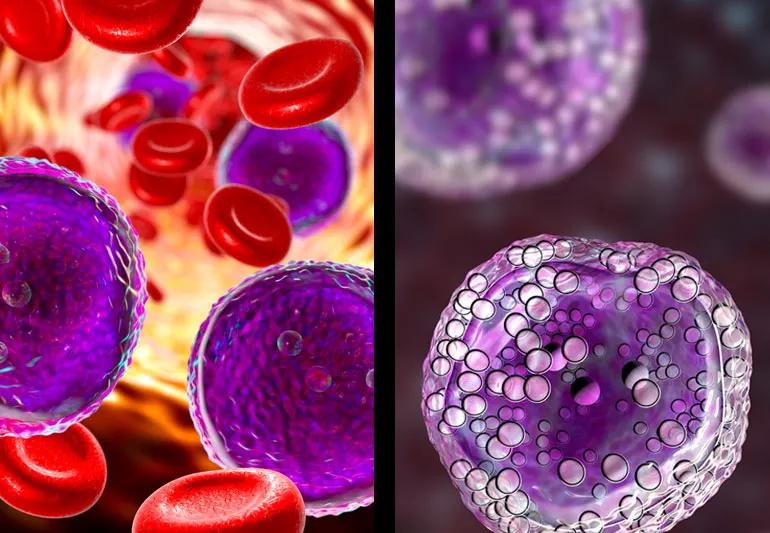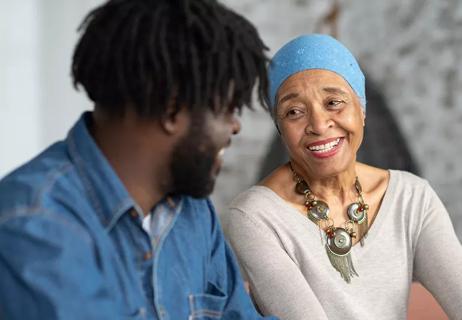Although related like cousins, they’re two different cancers

Cancer can be confusing and hard to understand. Sometimes we can’t picture what exactly is happening inside our own body, especially when it can affect any part. And if you mix in blood cancer, it can be even trickier to understand.
Advertisement
Cleveland Clinic is a non-profit academic medical center. Advertising on our site helps support our mission. We do not endorse non-Cleveland Clinic products or services. Policy
Some types of cancer have similarities and this is especially true of leukemia and lymphoma. Both are forms of blood cancer and both involve white blood cells, but the problems that each disease causes and the way they’re treated are very different.
“I would say leukemia and lymphoma are kind of related, like cousins,” explains hematologist Aaron Gerds, MD, MS. “The simplest way to think about it is that lymphomas are solid tumors made up of blood cells. This kind of cancer usually causes enlarged lymph nodes or solid masses. Leukemia, on the other hand, is seen in the bloodstream – it’s a liquid kind of cancer and it flows and is pumped around with the blood.”
If you’re still not sure you’ve got that, Dr. Gerds gives a more detailed breakdown of each:
Lymphoma is a cancer that specifically affects your lymphatic system. That’s the network of organs and tissues in your body that protects you against infection and gets rid of waste and toxins.
Lymphoma starts in lymphocytes, the types of white blood cells that are born in your bone marrow and circulate around in your blood until they mature and become part of your lymphatic system. Lymphocytes are part of your immune system. They’re meant to fight off bacteria and viruses, but sometimes they turn cancerous instead, growing out of control and not working properly.
Advertisement
There are two main types of lymphomas, Hodgkin lymphoma and non-Hodgkin lymphoma.
Leukemia occurs when your body makes abnormal white blood cells that don’t work the way they should. Quick Greek lesson: The name of the disease comes from the Greek words for “white” (leukos) and “blood” (haima).
Unlike lymphoma, leukemia won’t produce any sort of visible lump or bump (a tumor) that you usually associate with cancer. Leukemia begins when blood-making cells in your bone marrow don’t mature properly. Instead, these faulty cells start to grow in abundance and sometimes very rapidly in the bone marrow. They interfere with the bone marrow’s ability to make normal, disease-fighting white blood cells and other types of blood cells, like oxygen-carrying red blood cells. Leukemic white blood cells can’t fight infection properly. And if you don’t have enough red blood cells, you become weak and tired.
There are many types of leukemia. In general, they’re classified by the kind of cell the leukemia started out as (the cell of origin), and the speed at which the leukemia acts. Chronic leukemias are often slower-growing, while acute leukemias are fast and aggressive. Lymphocytic leukemia originate from disease-fighting lymphocytes in your immune system. Myeloid leukemias originate from cells that make white blood cells, red blood cells and platelets in your blood.
So although lymphoma and leukemia each include issues with white blood cells, the effects can be different on the body.
In lymphoma, cancerous white blood cells form tumors in the lymphatic system and interfere with its ability to fight off invading bacteria and viruses. And in leukemia, cancerous white blood cells disrupt the blood production and infection-fighting processes.
Advertisement
Learn more about our editorial process.
Advertisement

7 tips to guide you through their treatment

There are often options, even at age 99

This cancer of the blood is rarely passed down, but genetics can help determine risk

Certain foods like whole grains, eggs and nuts can boost your well-being during treatment

Listen to them, field questions from family and friends, and provide some normalcy

Most recommended precautions center around minimizing bruising or swelling

Even one drink can have an impact on your cognitive function leading to slurred speech, blurred vision and impaired memory

Type 2 diabetes isn’t inevitable with these dietary changes

Applying a hot or cold compress can help with pain